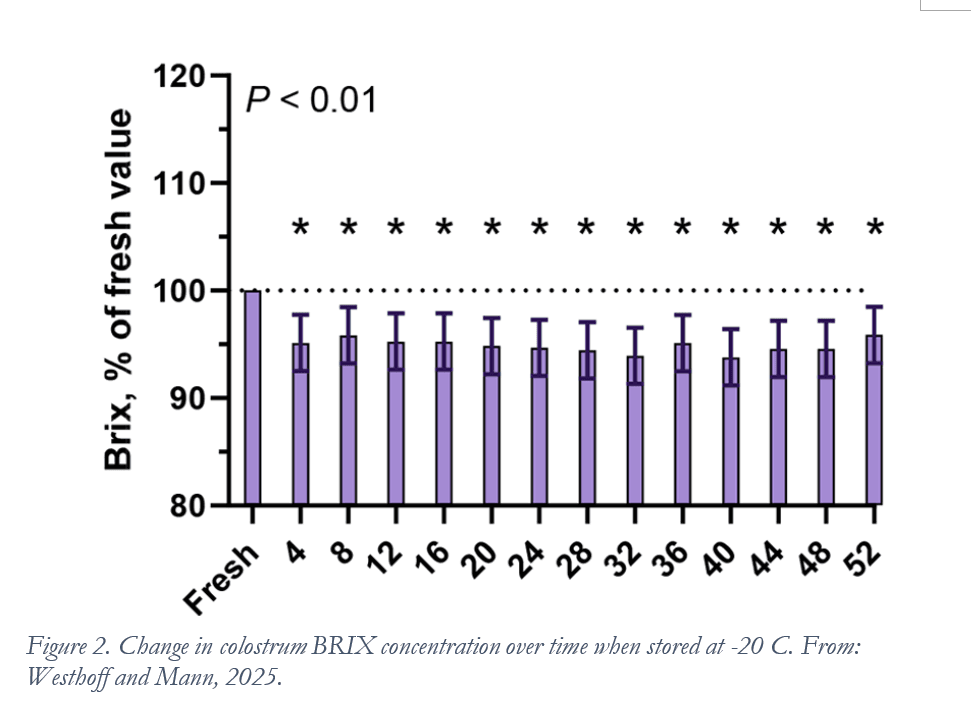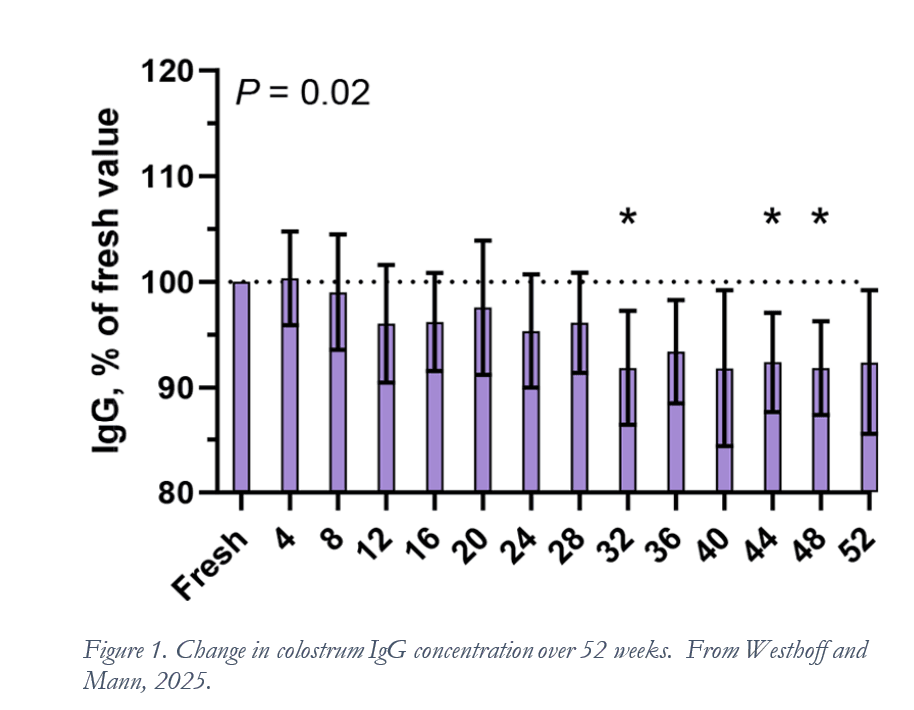Introduction
A frequent question asked by producers is “how long can I freeze colostrum”. It’s an important question, because we want to protect the sensitive immune components and nutrients in the colostrum. Storing for too long can pose a problem if these components start breaking down after a period of time.
There are several recommendations on how long to store colostrum in the freezer. Some recommendations range from about 6 months (Dairy Herd Management, Michigan State), 1 year (Calf Care.Ca, AHDB, NDSU) or longer (Calf Note 13). Calf Notes 215 and other resources distinguish between frost-free and non-frost-free freezers and suggest that frost-free freezers can reduce the shelf-life of frozen colostrum. Most of these resources don’t cite specific data regarding type of freezers or length of storage. Fortunately, some interesting new research from Cornell University sheds some light on some of these questions.
New Research
A study published in Journal of Dairy Science Communications (Westhoff and Mann, 2025) reported a study conducted in 2023 and 2024 do better understand the effects of long-term storage on colostral IgG concentration.
Samples of first-milking colostrum from 10 Holstein cows were collected and an aliquot was placed in storage tubes. One sample was analyzed immediately, and others were placed in a freezer at -20°C. One frozen sample was collected each week and analyzed for bacterial counts, immunoglobulins G, M, and A, BRIX, and insulin.

There were a number of interesting observations from the study, however, the most salient to this Calf Note was the change in IgG concentration over time (Figure 1). The authors reported the percentage of initial value (all the colostrum samples had different starting values) and it’s clear that concentration declined statistically (stars above the bars) beginning at 32 weeks.
So, what do these data mean practically? Let’s say we have 4 liters of colostrum that measure 100 grams of IgG per liter. By 32 weeks, the value would be around 91 g/L and about the same concentration thereafter. So, if we keep the colostrum past 32 weeks, we may see a reduction of about 10% in IgG concentration.
Another interesting observation was the change in BRIX concentration during storage. Figure 2 shows the change in BRIX over time compared to the initial value. There was a clear reduction in BRIX concentration when samples were frozen for any length of time. This has been shown previously and suggests that measuring BRIX is best done on freshly collected samples. Likely, the process of freezing changes the structure of colostral components such as fat, which, in turn, will change the refractive index and BRIX.

The authors did not report whether the freezer used was frost-free, nor the variation in temperature during the experiment. We often assume that freezer temperatures are always constant; however, this isn’t always the case, especially if the freezer is opened and closed frequently.
Frost-free freezers use a heating element and fan to melt the frost from the freezer coils, thereby eliminating the buildup of frost. A fan circulates air throughout the freezer, moving cold, dry air to keep the temperature consistent and prevent frost from forming. These coils are responsible for the cooling process. Periodically, a heating element warms the evaporator coils to melt any frost that has formed. A timer activates the heating element and fan system at set intervals (e.g., every 6-12 hours) to initiate the defrost cycle. The water from the melted frost flows down into a drain pan where it will evaporate. Samples that are not sealed properly may experience “freezer burn”, in which the areas “burnt” are dried out. It is unknown what effect this might have on the integrity of biologically active molecules such as IgG, but we know that oxidation (i.e., freezer burn) is not optimal for maintaining stability of bioactive molecules. Generally, it seems a good idea to seal colostrum in air-tight containers to avoid freezer burn.
Also, not all freezers are going to work the same, or maintain the same temperature. A good freezer should consistently maintain inside temperature at least -18°C (0°F). This ensure no bacterial growth and maintains integrity of the contents. Put a thermometer into the freezer (one that goes to -20°C or lower (-4° F) and check it regularly. If your freezer is in a barn exposed to big changes in temperature (as in a calf barn or milk house), make sure it’s maintaining targets in hot weather.
Summary
It appears that 32 weeks is the appropriate maximum length of time to store colostrum in the freezer, as defined in the Cornell study. Waiting longer than about 8 months results in about a 10% reduction in the original IgG concentration.
References
Westhoff, T. A., and S. Mann. 2025. Effect of frozen storage of bovine colostrum for up to 1 year on concentrations of immunoglobulins and insulin as well as bacterial counts. JDS Communications. 6:406–410. https://doi.org/10.3168/jdsc.2024-0731.